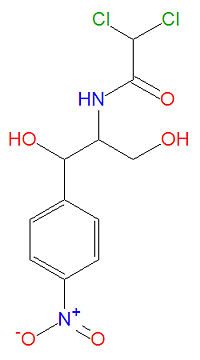Chloramphenicol: Difference between revisions
imported>Caesar Schinas m (Bot: Replacing medical templates with CZMed) |
imported>Howard C. Berkowitz No edit summary |
||
| Line 15: | Line 15: | ||
}} | }} | ||
'''Chloramphenicol''' was the first broad-spectrum [[antibiotic]] discovered, in 1947, from ''[[Streptomyces venequelae]]'' cultures. Although it is active against a wide variety of organisms including [[tetracycline]]-resistant [[vibrio]]s, toxicity and safety concerns, such as bone marrow damage and anemia, typically limits its use to only the treatment of very serious infections, such as cholera and typhoid fever. The antibiotic works by binding to bacterial ribosome 50S subunits and inhibiting bacterial protein synthesis. | '''Chloramphenicol''' was the first broad-spectrum [[antibiotic]] discovered, in 1947, from ''[[Streptomyces venequelae]]'' cultures. Although it is active against a wide variety of organisms including [[tetracycline]]-resistant [[vibrio]]s, toxicity and safety concerns, such as bone marrow damage and anemia, typically limits its systemic use to only the treatment of very serious infections, such as [[cholera]] and [[typhoid fever]]. The antibiotic works by binding to bacterial ribosome 50S subunits and inhibiting bacterial protein synthesis. | ||
{| " style="border: solid; center; width:450px;" | |||
!align=left colspan=3 style="background:#{{{color}}}"| "Therapy with chloramphenicol must be limited to infections for which the benefits of the drug outweigh the risks of the potential toxicities. When other antimicrobial drugs are available that are equally effective and potentially less toxic than chloramphenicol, they should be used." <ref>{{citation | |||
| title = Goodman & Gilman's The Pharmacological Basis of Therapeutics | |||
| edition = 9th Edition | |||
| publisher =McGraw-Hill | |||
}}, p. 1133</ref> | |||
|- | |||
|} | |||
== Chemistry == | == Chemistry == | ||
Chloroamphenicol, or 2,2-dichloro-N-[1,3-dihydroxy-1-(4-nitrophenyl)propan-2-yl]acetamide, has molecular formula C<sub>11</sub>H<sub>12</sub>Cl<sub>2</sub>N<sub>2</sub>O<sub>5</sub> and molecular mass 323.1294 g/mol. The drug is referred to by several names, including CAF, CAM, CAP, chloramphenicole, chloramfenikol, chloroamphenicol, cloroamfenicolo, CPh, D-Chloramphenicol. | Chloroamphenicol, or 2,2-dichloro-N-[1,3-dihydroxy-1-(4-nitrophenyl)propan-2-yl]acetamide, has molecular formula C<sub>11</sub>H<sub>12</sub>Cl<sub>2</sub>N<sub>2</sub>O<sub>5</sub> and molecular mass 323.1294 g/mol. The drug is referred to by several names, including CAF, CAM, CAP, chloramphenicole, chloramfenikol, chloroamphenicol, cloroamfenicolo, CPh, D-Chloramphenicol. | ||
== References == | == References == | ||
{{reflist}} | |||
{{CZMed}} | {{CZMed}} | ||
Revision as of 18:21, 23 August 2010
|
| |||||||
| chloramphenicol | |||||||
| |||||||
| Uses: | antibiotic | ||||||
| Properties: | |||||||
| Hazards: | toxicity | ||||||
| |||||||
Chloramphenicol was the first broad-spectrum antibiotic discovered, in 1947, from Streptomyces venequelae cultures. Although it is active against a wide variety of organisms including tetracycline-resistant vibrios, toxicity and safety concerns, such as bone marrow damage and anemia, typically limits its systemic use to only the treatment of very serious infections, such as cholera and typhoid fever. The antibiotic works by binding to bacterial ribosome 50S subunits and inhibiting bacterial protein synthesis.
| "Therapy with chloramphenicol must be limited to infections for which the benefits of the drug outweigh the risks of the potential toxicities. When other antimicrobial drugs are available that are equally effective and potentially less toxic than chloramphenicol, they should be used." [1] |
|---|
Chemistry
Chloroamphenicol, or 2,2-dichloro-N-[1,3-dihydroxy-1-(4-nitrophenyl)propan-2-yl]acetamide, has molecular formula C11H12Cl2N2O5 and molecular mass 323.1294 g/mol. The drug is referred to by several names, including CAF, CAM, CAP, chloramphenicole, chloramfenikol, chloroamphenicol, cloroamfenicolo, CPh, D-Chloramphenicol.
References
- ↑ Goodman & Gilman's The Pharmacological Basis of Therapeutics (9th Edition ed.), McGraw-Hill, p. 1133
The most up-to-date information about Chloramphenicol and other drugs can be found at the following sites.
- Chloramphenicol - FDA approved drug information (drug label) from DailyMed (U.S. National Library of Medicine).
- Chloramphenicol - Drug information for consumers from MedlinePlus (U.S. National Library of Medicine).
- Chloramphenicol - Detailed information from DrugBank.
